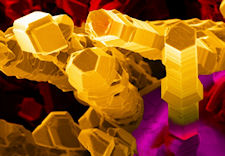The Future of Nanotechnology
The future of nanotechnology has been the subject scientific and nonscientific speculation including dystopian visions in popular culture that predict self-replicating nanoparticles taking part in massive assaults on humanity and the environment. An example of such a scenario is given in Michael Crichton’s popular novel Prey where “grey goo” self-replicates and overwhelms the world. These kinds of dire outlooks have accompanied some technologies when they entered our lives in the past (for example, robotics in the 1940s and 1950s), and the products of nanotechnology are no different when it comes to speculation about its impact on our lives. The more realistic vision for nanotechnology includes its use in medicine where nanoscale agents are placed in the blood stream for diagnostic and therapeutic purposes, but there always exists the possibility of development of new weapons of mass destruction enabled by nanotechnology.
In many ways, current products of nanotechnology are ordinary – reinforced composites for bicycle frames, stain-resistant clothes, better cosmetics and healthcare products, and medical diagnostic tests.
Some authors who consider the future of nanotechnology differentiate among incremental nanotechnology, evolutionary nanotechnology, and radical nanotechnology. Incremental nanotechnology is represented, for example, by reinforcement of current materials by nanoscale devices – leading, as in one application, to development of better paints. There are many products we use today that have been improved through the use of nanotechnology. Evolutionary nanotechnology involves more sophisticated tasks such as sensing and analysis of the environment by nanostructures, and a role for nanotechnology in signal processing, medical imaging, and energy conversion. Applications include targeted drug delivery and enhancement of components such as transistors, solar cells, light emitting diodes, and diode lasers. Significant improvements in the area of computing are expected from so-called evolutionary computing, allowing faster processing, miniaturized architectures, and increased storage.

and Gleb Yushin, Drexel University
Many of the more daring visions of nanotechnology emerge from the original vision of Eric Drexler in the late 1980s (Engines of Creation: The Coming Era of Nanotechnology). These anticipate the development of complex structures for nanoscale fabrication which employ tiny robots and vehicles. At times, the concepts in these visions have been criticized for their tendency to translate architectures and structures from other scales into the nanoscale without paying enough attention to the impact of scaling on the underlying physical laws – these laws often manifest themselves on the nanoscale differently from larger scales. Alternative approaches that were proposed (and are being actively pursued today) include “taking a lead from nature” – replacing the previously envisioned “hard” machinery (e.g., nano levers and cogs) by soft materials using the nanotechnology principles observed in cells and small organisms. Relevant ideas include the use of “molecular motors” that are incorporated into artificial nanostructures, and miniaturization of existing microelectromechanical systems (MEMS) into what has been dubbed nanoelectromechanical systems (NEMS).


